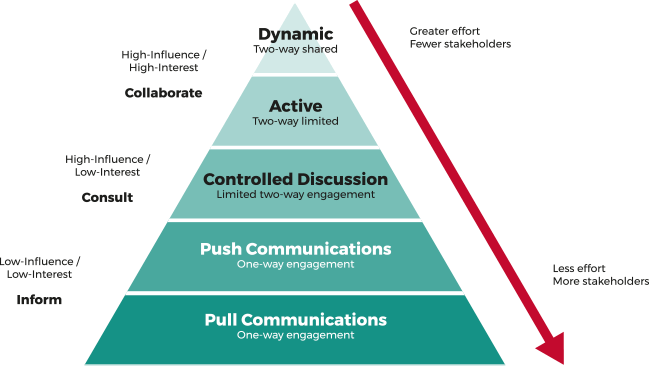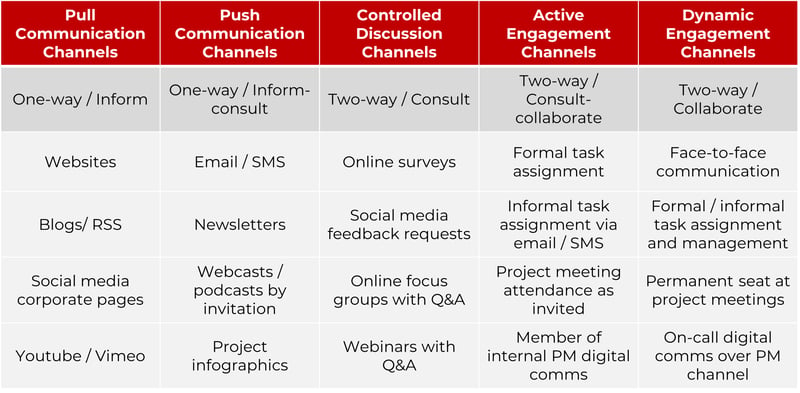There is a hierarchy of engagement amongst the digital channels and tools you use when dealing with stakeholders.
In this post, we want to help you understand how this works and how this can help you deliver more effective stakeholder engagement!
We'll go through the hierarchy of engagement and each of its levels:
- The stakeholder engagement hierarchy;
- Pull communication channels;
- Push communication channels;
- Controlled discussion channels;
- Active channels;
- Dynamic channels;
- Communication channels examples.
The stakeholder engagement hierarchy
Let’s look at it as a pyramid system where each level of the hierarchy involves a different level of stakeholder engagement.

The pyramid image shows the parallels between the levels of engagement (on the left side) and the communication methods commonly used for each level, considering how much effort is required and the number of stakeholders involved.
The stakeholder communication channels
Let's look into how each communication method works to accomplish the intent of inform-consult-collaborate with stakeholders:
Pull communication channels
Pull communication channels are those where you frequently publish corporate and project information for the taking.
In other words, the stakeholder has to take the initiative to look for it.
Your only responsibility is to provide the low-interest/low-influence and borderline low-influence/high-interest stakeholders with the links to the information.
Examples of pull communication channels
- Project website: This is where you can publish information about the project, such as project timelines, progress updates, and project documents ls.
- Social media: Social media platforms like Twitter, LinkedIn, and Facebook are great for sharing project updates, news, and other information.
- Newsletters: A project newsletter is a great way to keep stakeholders informed about project progress, milestones, and other developments, and can be sent out on a regular basis.
You must ensure that the information you provide is easily accessible and clearly communicated so that stakeholders can find what they need.
Push communication channels
Push communication channels differ from pull channels in that you are directly sending the information to the attention of the stakeholder, rather than waiting for them to seek it out.
It can be done using a group email collective address from your CRM or you can target one of your four segmented groups according to your engagement grid categorisations.
Push communication channels examples
- Emails: You can send targeted emails to stakeholders to provide updates, news, or specific information about the project.
- Text messages: Text messaging is a great way to quickly and directly communicate with stakeholders who have expressed interest in receiving project updates via this type of communication channel.
- Phone calls: In some cases, a phone call may be the most effective way to communicate with a stakeholder. This may be necessary for higher-influence stakeholders who require a more personal touch.
Do not overthink this group. Avoid addressing your stakeholders individually, segment them into appropriate groups to ensure that you're sending relevant information to the right people, and stick to the group approach to limit your investment of time.
The added feature here is that the content of the communication is more focused on providing specific project updates and information.
Controlled discussion channels
Controlled discussions are situations where you want to solicit specific input from a particular group of stakeholders.
It’s a two-way communication path that allows stakeholders to provide feedback, comments, or suggestions about specific topics related to the project - but it’s not live. You are limiting the interaction to written exchanges of information over a digital medium.
Examples of controlled discussion channels
- Online forums: An online forum allows stakeholders to post and reply to messages about specific topics related to the project. It can be useful for soliciting feedback from stakeholders who may not be able to attend in-person meetings.
- Surveys: Surveys are a great way to gather feedback from stakeholders on specific topics related to the project. Surveys can be distributed via email, social media, or other channels.
- Focus groups: A focus group is a small group of stakeholders who are brought together to discuss specific topics related to the project. Focus groups can be held in person or virtually.
Controlled discussion channels are useful for engaging stakeholders who have a higher level of interest or influence in the project.
The frequency of these interactions is also controlled with a target of once-a-month encounters with a provision for special occurrences when the project needs some specific feedback.
Active participation channels
Active participation is where you include stakeholders as part of the project team.
They become registered resources in a project management system and can be seen in the list of available resources when choosing to whom a task will be assigned.
Active participation channels examples
- Project management software: It allows stakeholders to access the project plan, tasks, and timelines. Stakeholders can be assigned specific tasks and can track their progress through the software.
- Meetings: Stakeholders can be invited to attend meetings related to their assigned tasks. This allows them to provide feedback and suggestions on the tasks they are working on.
- Collaboration tools: Tools like Slack, Microsoft Teams, or Asana can be used to communicate and collaborate with stakeholders. They allow stakeholders to share documents, provide feedback, and collaborate in real time.
Stakeholders with this level of interest/influence will have limited hours available and normally have a narrowly defined role with equally bounded responsibilities based on their skills and knowledge.
Dynamic engagement channels
The highest level of engagement in the stakeholder engagement hierarchy, the dynamic partnership occurs continuously with shared accountability and responsibility for the project's health.
This group of stakeholders is your peer group. They have as much experience - and in some cases more experience - in specific disciplines than you, and can provide valuable insight into the project's progress.
Examples of dynamic engagement channels
- Joint decision-making: Stakeholders at this level are involved in the decision-making process and have the authority to make decisions related to the project's direction and scope.
- Co-creation: Stakeholders at this level are involved in the creation of project deliverables, such as reports or presentations. They may also be involved in the creation of project plans and timelines.
- Delegated management: Stakeholders at this level can be delegated to manage project team members and provide leadership in specific areas of the project.
Ensure that stakeholders at this level have clear roles and responsibilities, and are empowered to make decisions and take action. Effective communication and collaboration are critical for success at this level of engagement.
Communication channels examples
A few of the more common digital channels for each communication method:

Creating a stakeholder engagement strategy that applies the appropriate communication channel to each category of stakeholders will help you obtain the level of engagement necessary to support your project's success.
Improve your stakeholder communication
Deliver better stakeholder engagement using all the communication tools you need in addition to stakeholder mapping, data analysis, insightful reporting and more.
Tractivity can help with all your engagement needs in a centralised, GDPR-compliant solution. Contact us today to learn how we can support you.

